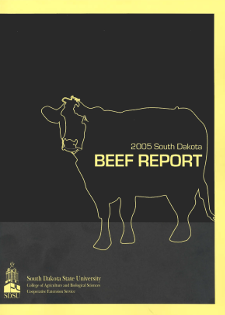Document Type
Report
Report Number
2005-2
Publication Date
2005
Keywords
heifer calves, weaning management, drylot
Summary
In a three-year study at the SDSU Cow/Calf Teaching and Research Unit, Brookings, SD, heifer calves were allotted to two weaning management treatments in early October. The pasture-weaned group was separated from their dams and grazed a grass pasture across the fence from their dams for two weeks. Then, until early December, they grazed “Robust” barley (forage type) that had been no-till planted into oat stubble in early August. The drylot-weaned group was fed a traditional weaning diet of grass hay, corn and protein supplement from weaning until early December. Heifers received the same diet and were managed as one group from December until April. The effect of management on heifer weight gain depended on year. In the first two years gains for two and four weeks after weaning were affected by weaning treatment, but gains from weaning to December and April were similar. In the third year gains of heifers while grazing forage barley were less from weaning to December and April than those in dry lot. Pasture weaning appeared to cause less stress for both cows and calves, but no differences in incidence of disease were observed. Antibody titers for IBR, BVD type 1 and BVD type 2 were determined at weaning and two and four weeks after weaning to measure the development of immunity from vaccinations administered about two months prior to and at weaning. There was no overall effect of treatment on antibody titers, but there was an interaction of treatment and year for BVD type 1 at 2 weeks after weaning but not by 4 weeks. The percentage of heifers with positive titers was similar at all three sampling times. Heifers fed in drylot had more backfat, larger rib eye area, and % intramuscular fat in April. The results of this study indicate fenceline weaning on pasture combined with small grain pasture to extend the grazing system is a feasible alternative for managing replacement heifers compared to a traditional drylot weaning system. As would be expected, forage conditions as affected by year can influence performance. Weight of calves at weaning and forage conditions influence the need for supplementation.
Number of Pages
5
Format
application/pdf
Language
en
Publisher
South Dakota State University
Rights
Copyright © 2005 South Dakota State University
Recommended Citation
Pruitt, Dick; Epperson, William; Owens, Vance; and Smart, Alexander, "Fenceline Weaning on Pasture and Forage Barley to Extend the Grazing Season for Replacement Heifers - a Three-year Summary" (2005). South Dakota Beef Report, 2005. 3.
https://openprairie.sdstate.edu/sd_beefreport_2005/3

